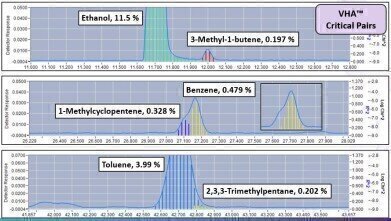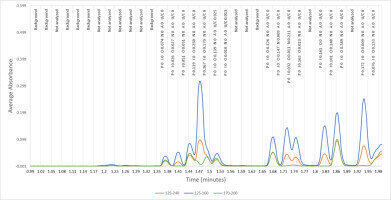-
 Figure 1: Critical pairs deconvolved with VHA.
Figure 1: Critical pairs deconvolved with VHA. -
 Figure 2: Time Interval Deconvolution.
Figure 2: Time Interval Deconvolution.
Analytical Instrumentation
Detailed Hydrocarbon Analysis - Past, Present and Future Part 2
Jun 17 2020
In part two of this series I want to focus on the future of detailed hydrocarbon analysis. If you remember my first article, I talked a little about my experience in shaping what DHA has become today. That future uses vacuum ultraviolet spectroscopy (VUV) in an application called Verified Hydrocarbon Analysis™ (VHA) that maintains the advantages of DHA all while eliminating the drawbacks, resulting in more accurate data, increased productivity, and ease-of-use.
What is VUV Spectroscopy and VHA? VUV Spectroscopy takes advantage of the VUV region of the electromagnetic spectrum which is characterised by high-energy and short wavelengths of light from 125nm to 240nm. Every compound absorbs here except for carrier gasses (i.e, hydrogen, helium, and argon). More importantly, every compound has a unique spectral fingerprint. These make it possible to accurately identify compounds of interest using a library of spectra. The VHA library covers most hydrocarbon compounds of interest.
One of the biggest challenges associated with the traditional 100-meter DHA method is achieving the separation necessary to ensure accurate identification of all compounds of interest – especially critical pairs (figure 1). These are closely eluting compounds of very similar boiling points. To achieve separation, a tuning column is often required and run times can be over 140 minutes. Since VHA uses spectral fingerprints, critical pairs need not be completely separated; therefore, shorter columns can be used which accelerates analysis time while ensuring accuracy.
Misidentified or unidentified peaks using DHA occur because identification depends solely on retention time and operator interpretation -- many coelutions still occur. Alternatively, VHA identifies compounds and classes not only by a retention window, but also by a compound’s unique spectral profile. The absorbance or response is directly proportional to concentration and allows accurate quantitation using similar normalization calculations as DHA. VHA also uses the predictable response of analytes to eliminate calibration requirements. During VHA data processing, most gasoline compounds are “verified” by their unique spectra in the VHA library. When an exact match is not made, the hydrocarbon class and carbon number is assigned, made possible because compounds in a hydrocarbon class share spectral similarities. Every time interval is analysed, resulting in zero “unknowns” compared to traditional DHA.
One of the core concepts of VUV Spectroscopy is that traditional peak integration is not performed. There are no peak starts, ends, tangent drops, or baseline considerations that DHA analysts spend significant resources on. Even experienced operators may miss that the baseline follows valley to valley peaks points, omitting a large portion of FID response under a region of closely eluting compounds. This is a common DHA error source. Instead, VUV spectroscopy uses Time Interval Deconvolution™ (figure 2). These time intervals, like time slices in GC distillation methods, are individually analysed to solve the entire chromatogram. This eliminates peak integration and allows automated processing.
The future of hydrocarbon analysis is VHA. This method provides the detailed analysis that is required while improving accuracy through spectral verification, increasing productivity from faster analysis time, less human intervention, and is easier-to-use.
By: Dan Wispinski
Digital Edition
PIN 25.1 Feb/March
March 2024
In This Edition Safety - The technology behind the ION Science Tiger XT - Safety with ammonia and LOHCs as hydrogen carriers Analytical Instrumentation - Discussion on new tribology te...
View all digital editions
Events
Apr 28 2024 Montreal, Quebec, Canada
Apr 30 2024 Birmingham, UK
May 03 2024 Seoul, South Korea
May 05 2024 Seville, Spain
May 06 2024 Riyadh, Saudi Arabia

















